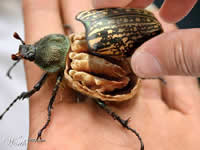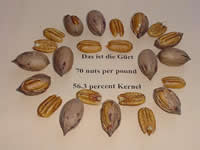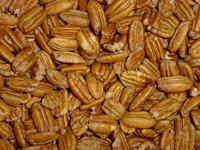
Pecan Beetle |

Dr. Larry Stein explains pecan grafting in one of many
demonstrations he conducts throughout the state |

Cracked in-shell and shelled Stein Pecans |

Shelled Stein Pecans |

Farm dogs love shelled pecans |

Larry Stein has his sons help harvest pecans as they jump
for the nuts from their trampoline in 2004 |
It must be pecan harvesting time in South Texas because I am
already getting telephone calls at home from people wanting
that "special" pecan I introduced to the market in
December, 2004. Dr. Larry Stein, Texas A&M Extension Horticulturist
wrote about his Alsatian family' pecan in the article at: http://www.plantanswers.com/garden_column/dec04/1.htm
He wrote: "Over the years my family identified trees that
they would harvest for their own use because of the outstanding
qualities of the tree and nut. Today, we propagate one which
they considered to be their very best-- i.e., Das ist die Guet!,
meaning this is the "good!" in the Alsatian language.
Three such Guets were identified, but only this one was propagated
and today it is simply known as the "Guet". This pecan
shells in perfect halves at 53 to 56 percent kernel; has very
wide dorsal (upper) grooves and little if any ventral groove;
ranges in size from 65 to 70 nuts per pound and has an awesome
flavor. One drawback to the nut is that it turns dark fairly
quickly, presumably from the high oil content!"
If you are interested in seeing how these nuts are actually
harvested and have a fast speed modum, go to:
http://aggie-horticulture.tamu.edu/archives/video/detail.php?vidid=27&size=largevid
and
http://aggie-horticulture.tamu.edu/archives/video/detail.php?vidid=28&size=largevid
The older generation literally "went nuts" after hearing
they could purchase shelled kernels of a superior, "oily"
native pecan which was selected by the Stein family over 100 years
ago. These are the pecans older citizens remember harvesting and
eating when they were children. People are demanding more product
so these shelled nuts will be available again this year ONLY at
Milberger's Nursery (3920 North Loop 1604 East - at the corner
of Bulverde Road & Loop 1604) while Dr. Calvin Finch and I
are doing the Milberger's Garden Show live on Saturdays and Sundays
from 12:00 p.m. to 2:00 p.m. on KLUP Radio (AM 930) For more information
and to have your gardening questions answered during show hours,
call 210-308-8867 or 1-866-308-8867. You can listen to the program
live on the Internet by going to: http://www.klup.com/
during show hours.
How much will they cost per pound of shelled kernels? Dr. George
Ray McEachern, retired pecan specialist with Texas A&M Cooperative
Extension sets the price in this wonderful article he wrote about
pecan production. He states: " Pecan kernels at $5 a pound
are a great buy, plus they not only taste great, they make everything
they are added to taste better." Then he continues to explain
the production of pecans:
"When it comes to getting the job done, pecans are as efficient
as any plant on earth. For years many felt the pecan tree - via
photosynthesis and all of the metabolic pathways within its foliage
- failed to measure up when compared to other crops. The big deal
now is how well does a plant measure up with a given volume of
water. Can pecan compete?"
"Walnuts can bear up to four tons per acre, grapes can bear
up to 10 tons per acre, cabbage and spinach 10 tons, Irish potatoes
25 tons, and carrots, watermelons, and tomatoes all can bear up
to 30 tons per acre. But these products are mostly water. Since
pecans are mostly oil (up to 70 percent mono-unsaturated oil),
the pecan is very efficient."
"Moving water from to the soil to the fruit is no big deal;
but making pecan oil via the fatty acid cycle is a very difficult
but efficient process. I would say it is like comparing 100 pounds
of iron to one pound of gold -- which would you rather have?"
"Unfortunately, the public does not recognize how nutritious
the pecan is and how hard the tree has to work to produce it."
"Growers must also work with the pecan tree to maximize the
potential of the pecan. The public needs to know pecans require
deep, well-drained fertile soil which also needs irrigation up
to 60 inches per year, 100 pounds of actual nitrogen fertilizer
applied throughout the spring and early summer, up to five foliar
zinc sprays, protection from insects and disease, light into the
canopy via wide spacing or hedging, trunk shaking in July and
August to reduce over cropping, weed control to optimize water
and nutrients, and avoiding any and all stress in August and September
to obtain complete shuck opening and early nut harvest. Once the
pecan shucks open, growers must shake the tree and harvest the
kernels as soon as possible to prevent the kernels from turning
dark."
"The nuts must then be dried from 20 percent moisture down
to less than six percent so the taste and nutrient quality of
the kernels is complete. Once purchased, consumers should store
the pecans frozen to protect the quality."
"Few crops have so many factors influencing their tonnage
and quality. In addition to these, the cultivar and climate with
all its variations play a major role in establishing pecan yield
and quality. Few foods are produced with greater work than the
pecan and its growers."
Then to make you feel really good about: "Pecan kernels
at $5 a pound being a great buy", nuts are listed as number
seven in Top 10 Amazing Disease-Fighting Foods in a recent article
on the popular WebMD Internet site. Here are excerpts from the
article:
"They are a dietitian's dream foods, the cream of the crop,
nutritious and delicious. They are foods that should be in everyone's
kitchen because they contain such a wealth of disease-fighting
substances.
"So put these 10 readily- available foods on your grocery
list today - but do keep in mind that it takes more than 10 foods
(even 10 terrific foods!) to make a healthy diet. Experts are
quick to point out that variety is the spice of life. And ideally
these nutritious nibbles should replace other, less healthful,
foods -- helping you to cut calories while boosting the nutrition
in your diet.
Top 10 Amazing Foods
1. Berries- Reach for berries for a powerful dose of
health -protecting antioxidants.
2. Dairy -- Dairy foods are not only the best food
source of dietary calcium, but also have plenty of protein, vitamins
(including vitamin D), and minerals.
3. Fatty Fish -- The fat found in fish like salmon and
tuna is rich in omega-3 fatty acids, which can help protect your
heart.
4. Dark, Leafy Greens -- Dark, leafy greens everything
from spinach, kale, and bok choy to dark lettuces are loaded with
vitamins, minerals, beta-carotene, vitamin C, folate, iron, magnesium,
carotenoids, phytochemicals, and antioxidants.
5. Whole Grains - Whole grains contain folic acid,
selenium, and B vitamins, and are important to heart health, weight
control, and reducing the risk of diabetes.
6. Beans and Legumes - These nutritious nuggets are
packed with phytochemicals; fat -free, high-quality protein; folic
acid;
fiber; iron; magnesium; and small amounts of calcium.
7. Nuts - Nuts are full of fats. But they're the
healthy, mono- and polyunsaturated kind, which can help lower
cholesterol levels and help prevent heart disease. In addition,
nuts are
a good source of protein, fiber, selenium, vitamin E, and vitamin
A.
Small portions of nuts can boost energy and beat hunger, helping
dieters
stay on track. Still, nuts pack plenty of calories -- and it's
easy to
overeat these tasty treats. So enjoy nuts, but be mindful of your
portion size. Try to limit yourself to an ounce a day. That's
about 28
peanuts, 14 pecan halves, or just 7 Brazil nuts.
8. Sweet Potatoes
9. Tomatoes
10. Eggs
See the full article at:
http://www.webmd.com/content/article/108/109017.htm
|



